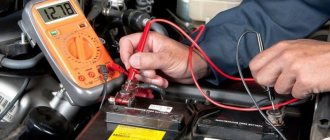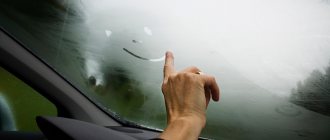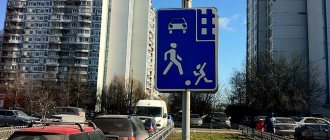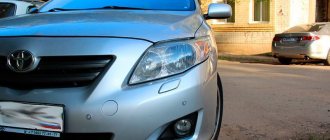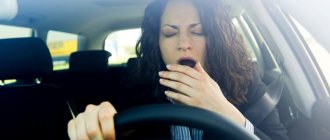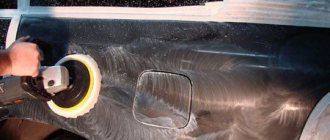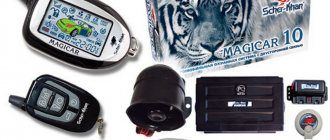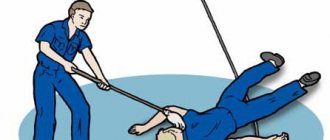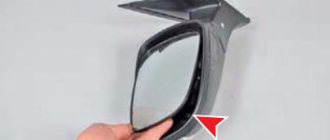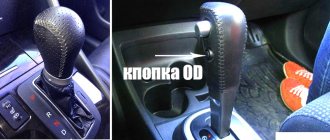Accidents on the road happen every day; at best, damage is caused only to cars. But often people also receive some kind of injury. In any case, this is always unexpected and a person, finding himself in such a situation, is simply lost and does not know what to do, even if he is the culprit of the accident. There is a special procedure that must be followed after an accident.
Procedure in case of an accident in 2020
A person involved in an accident begins to feverishly think about what to do and what actions to take. There is no need to waste time on phone calls to friends, relatives and acquaintances. The best assistant is the emotionless state of drivers and passengers. You should be extremely focused, focused and concentrated. This is the best advice regarding the internal mental state.
No driver is insured against an accident, even if you strictly follow the traffic rules
What to do in case of an accident without injuries?
Let's consider the most favorable outcome - an accident without injuries. First of all, the alarm system turns on and an emergency sign is displayed. In the dark, wear a reflective vest.
After a minor accident with little damage has occurred, you can proceed in several ways with or without the involvement of traffic police officers. If inspectors are called, the wait will take three or more hours.
A single emergency number 112, which you can call for free on a mobile phone even if your SIM card is missing or blocked . The request is immediately transmitted to the appropriate authorities. The standard call to the police via cell phone is 102.
As a rule, representatives of the inspection are called in controversial situations when drivers have failed to reach an agreement. There is no agreed position on how to pay for the damage. The police interview each driver, receive explanations, and draw up a report.
Each driver is free to present his own version. If one of the participants does not agree with the statement of the opposing party, explanations, reasoned comments, facts about the case and conclusions are sent to the inspectorate.
If possible, photographs and video materials and an express interview of another participant are provided. In case of legal proceedings, the collected documents are transferred to the human rights body as evidence to support their position.
What to do without calling the traffic police:
- Agree and part ways. A driver who voluntarily pleads guilty pays damages on the spot, in agreement with the other participant. Damage is assessed based on a purely subjective opinion with a small additional payment for any inconvenience caused. They exchange receipts, which each driver representing one side or another receives;
- Drawing up a European protocol. The document is drawn up if each participant has an MTPL policy. All points of the form are filled out indicating the time and place of the incident. The signature of both drivers is affixed.
Actions are coordinated in the manner prescribed by the traffic rules. Namely, independent recording of the position of cars during a collision and the resulting damage. But the traffic regulations do not specify what drivers should do if they do not have photo and video recording equipment at hand.
In any case, the law requires that cars be removed from the scene as quickly as possible. Otherwise, the same rules impose sanctions in the amount of 1,000 rubles from each driver, who leave the car for a long time after the accident and the formal procedures for establishing damage when agreeing and compensating for damage.
Drivers are often able to deal with minor incidents on their own. The MTPL policy protects against motor vehicle liability, and the traffic police are involved in exceptional cases.
What to do in case of an accident with injured or dead people?
The worst option is an accident with victims, where a lot depends on the actions and composure of the driver. There are clearly defined regulations in the rules.
Prioritization:
- The object of primary importance is the provision of medical care to the victim. You must call emergency medical assistance using the single number 112 or 103;
- Before the arrival of traffic police officers, who are called after medical assistance, the driver needs to look around, write down possible eyewitnesses;
- Take the contact details of witnesses and ask them to wait for the traffic police. In especially serious cases, it is necessary to wait for the investigator or investigative team;
- Use a video recorder or phone to try to record traces of the incident. Take photos and videos, look at the braking distance;
- In case of an accident with pedestrians, the direction of movement of the victims and moving vehicles is recorded;
- Remove damage to your car, traces, integrity or damage to wheels and the location of vehicles;
- Pay attention to whether there are holes, potholes, signs, markings on the roads, and record the operation of the traffic light.
The point is to witness as many objects as possible that will help in the further investigation of the case. The fall of soil clearly characterizes the scene of the incident. Oil and brake fluid spills are all traces that are an integral part and are subject to investigation when determining who is at fault for the incident.
What is the Europrotocol?
If the damage is minor, you can agree to register the accident under the European protocol, which has been in force in Russia since 2009. Based on the nature of the damage, the loss is estimated at no more than 50,000 rubles. There must be a mandatory consent of the two participants about the violation of traffic rules by one of the parties. The first step is to check the offender’s documents and the current MTPL insurance policy.
How to make sure the policy is legal:
- The document must contain watermarks;
- A metal tape (hologram) is detected in the light;
- The imprints of the numbers are checked by touch with your fingers. Volume should be felt;
- According to Civil Law, a contract is concluded by two parties: the policyholder and the insurer. Participants must be enrolled in the policy.
The European protocol is drawn up only by the participants in the accident themselves. When concluding a compulsory motor liability insurance agreement, a notice-memo for filling out is attached. It specifically describes how the protocol is filled out. Each agent issues complete instructions for use and the protocol itself. Mandatory condition: the document must be made on self-copying paper with printed sheets.
Participants in an accident can agree on their own and fill out a European protocol
Calling the emergency commissioner
An emergency commissioner is sometimes called to the scene of an accident as an alternative to the traffic police. An emergency commissioner is an expert from an insurance company or an employee of an outsourcing company with which the insurance company enters into an agreement for the provision of emergency commissioner services.
Responsibilities include:
- Departure to the scene of an accident at the customer’s address or location;
- Drawing up a road accident diagram;
- Assessment of damage caused to the vehicle;
- Conducting consultations on what needs to be done to restore the car and bring it into proper condition;
- Preparation of necessary documents for vehicle repairs;
- Protection of rights in insurance companies, traffic police and in court.
Some insurance companies require photos or videos of damage. To identify and confirm the make and model of the vehicle, four diagonal photographs are taken from all angles. Next, a detailed survey takes place: what is damaged, what parts, and the nature of the damage is described.
The procedure is necessary so that the expert of the insurance company, to which the commissioner submits the report, makes a decision on repairs or payment of funds for the repair of equipment.
A set of documents is being compiled:
- Application from the insured driver or an authorized representative;
- Documents for the car;
- Damage inspection report. The make, model, equipment, type of body damage, recommendations for vehicle restoration are indicated;
- An inventory of the documents provided for registration of the insured event is made.
The driver can, on his own initiative, call the emergency response team when help is needed. One-time services are provided or an annual subscription for ongoing service is purchased. The accident commissioner will become an assistant to the driver who was involved in the accident.
The accident commissioner will competently draw up legal papers and independently transfer them to the insurance company
Calling a traffic police officer
The incident is first reported to the duty station. The duty officer directs the outfit. Before the inspector arrives, the picture of the accident must, if possible, be recorded in its original form, without touching anything: scattered fragments, bumper marks, soil debris.
For the driver, this may be an insignificant item, but for the investigative team, the untouched items will become important evidence that can further prove innocence. After filming, if the accident is not significant, the vehicle is removed from the roadway so as not to interfere with traffic.
Before drawing up an accident diagram, you need to look around, find out the nearest address, and check the time of the incident with other participants. Instead of a ruler, you can use a driver's license or vehicle certificate.
The diagram shows:
- The roadway indicating road markings and additional ones, if any;
- The location of vehicles before and after the moment of collision;
- The triangle indicates the front of the car;
- Numbers or letters indicate vehicles and the direction of travel before the collision;
- The location and area of the collision are indicated, indicating the streets, nearest building or house;
- At the top of the diagram the address, date and time of the accident are signed;
- At the bottom, the contact details of the participants, driver's license numbers, license plates and brands of cars, addresses, telephone numbers, names of eyewitnesses, symbols are recorded;
- Participants and eyewitnesses must put their signatures on the diagram.
The participant in the accident is given:
- Road accident diagram;
- Protocol-resolution regarding the culprit or a ruling on the refusal to initiate proceedings on an administrative offense;
- A certificate of an accident, which the employee makes on the spot. Information about the driver, vehicle, vehicle owners and insurance company data are provided.
If disagreements arise and the driver does not agree with the conclusions, there is a “Comments” column at the end of the form, where all objections must be written down. Employees' actions are allowed to be filmed on the phone. The very fact of turning on the phone forces the traffic police to record objective data in the protocol.
In an accident with injuries or deaths, the case is administrative or criminal in nature. The participant in the accident has the right to invite a qualified lawyer to the scene of the accident. From little things, expressed in seconds, the guilt or innocence of the driver is then born.
If the participants in an accident have disagreements, then you must call the traffic police by calling 102
In a collision
How to behave correctly in case of an accident
If a collision is imminent, the biggest mistake would be to try to leave the car while it is moving. No need to give up the steering wheel. Try to mitigate the negative consequences until the moment of the accident. Maintaining composure, try to change the trajectory of the movement, turning the central blow into a side kick. Remember that driving into a ditch or colliding with a tree or other immovable obstacle is better than colliding with a speeding car.
Rules of conduct in case of a car accident include the following actions, which will increase the chances of survival in a collision:
- Resist moving your body forward by using the floor for support.
- While protecting your head, fold your hands crosswise on the steering wheel or dashboard, placing your head between them.
- Tighten all the muscles in your body as much as possible
- People in the back seat are advised to cover their heads and lean sideways or fall to the floor.
- If you have an airbag, lean your chest against the steering wheel
- If there is a child in the cabin, you need to cover him with yourself and take a side position with him.
- Children under 12 years of age are prohibited from sitting in the front seat. This is due to the fact that in a collision the doors can be severely damaged, and you will need to get out of the cabin through the windshield.
After a car accident, assess the situation. It is necessary to find out what condition the machine itself is in. Are there any gasoline leaks, fires, sparks, or a suspicious odor? If possible, you should leave the salon immediately.
If the car is overturned, then before leaving the car, make sure that there is no possibility of another rollover. It is also risky to rock the car with your movements if you are on a steep slope or near a cliff. In such situations, it is better not to move and wait for professional help.
If there is a risk of fire or explosion, you should be extremely careful when getting out of an unstable vehicle. Use windows that face the top of the slope. The passenger who escapes from the cabin must help the remaining victims.
Only after there is no one left in the cabin should you move to a safe distance. Trapped people in a car should not be pulled out by force. Call rescuers and an ambulance.
Actions after registration of an accident
The actions are aimed at making it faster, easier and simpler for the injured party to receive insurance compensation, and to avoid any complications in the damage caused to this party.
What should the victim do?
There are two options: contact your insurance company or the insurance company of the person at fault for the accident. If there were no casualties, no more than two cars were damaged in the accident, and both drivers have a compulsory motor liability insurance policy, the victim contacts his insurance company.
When several vehicles were damaged in an accident, there were casualties and personal injury, the direct conditions for compensation for damages are considered unfulfilled. In this case, contact the insurance company of the person responsible for the accident.
- First of all, it is necessary to obtain information about the availability of insurance policies from other participants in the accident. The easiest way is to take photos from your phone;
- Drivers must fill out the MTPL notice. If several cars were damaged, the form is filled out in pairs with each participant.
Within five days you must contact the Investigative Committee and submit an application. If time is lost, compensation may be denied .
If insurance does not cover the damage
After an accident, the insurance company has every right to demand that the vehicle be provided for inspection. Insurance coverage limits are determined by the date the at-fault party purchased the policy.
Damage to the car may exceed the established insurance limit if compensation payments are underestimated or the maximum possible amount is received, but the cost of repairs turns out to be higher.
The assessment examination is carried out within five days after submission of the application. The accuracy of the calculation can be approximately assessed using reference books on the RSA website. In case of underestimation, the calculation is considered incorrect.
During the trial with the insurer, evidence of the amount of damage and the cost of restoring the vehicle will be the conclusion based on the results of an independent examination.
The procedure is carried out by an expert technician included in the register by the Ministry of Justice according to a unified methodology for using the database of the Union of Auto Insurers. It is necessary to follow the pre-trial procedure for resolving the dispute and contact the insurer with a claim.
Based on the results, a payment is made or a refusal to satisfy the claim is sent. Within ten calendar days, in case of refusal or lack of response, you can go to court.
If the payment for an accident is insufficient, it is possible to conduct an independent examination at your own expense
Further actions of the driver
When all the initial points have been settled, it is important to understand how to proceed further.
What to do with the car
After an accident, a car owner usually has a question about whether or not it is worth repairing it and driving on. Such thoughts are especially common in the presence of severe damage. There are several options:
- Sell your vehicle to buy used cars. There are companies that do this. This option saves time and makes it possible to immediately receive a certain amount of money. This option is suitable for those who do not intend to restore their car and continue driving it. The disadvantage of this solution to the problem is that buyers will give a minimum amount of money for a damaged car.
- You can try to sell your used car yourself. This can take a long time, since few people would want to take on such a problem. The amount of money received from the sale is unlikely to be much greater than in the first case, and it will take much longer.
- Repair and sell. This is what those who want to spend a minimum of money on repairs try to do, and then profitably sell a damaged car as one that has never been involved in an accident. In some cases, scammers hide serious damage that violates the geometry of the body. If you follow this path, you need to be prepared for the truth to be revealed.
Read also: Experience for obtaining a veteran of labor
Independent examination
An independent examination is an assessment of a vehicle by a third-party company to determine the actual damage received as a result of an accident. It is necessary if the car owner wants to make sure that the insurance company’s charges are correct, if there are suspicions of unaccounted for defects, or if a trial is planned. It will also be needed to determine the amount of car repairs.
In order to conduct an independent examination, you must:
- Select a company and conclude an agreement with it, pay for the service.
- Indicate the date and location of the vehicle inspection. To do this, you need a car service, where there are conditions for carrying out this procedure.
- Next, you need to notify the insurance company and the person responsible for the accident that an independent examination is being carried out. This is done by sending a letter to interested parties.
- Specialists conduct an examination and, based on its results, draw up a report: all calculations will be based on it.
- Further, with the help of special programs, these calculations are carried out in the same expert company. The result is a calculation of the necessary work and the cost of it.
- The final point is to get a report on the work done from an expert company.
What to do if the culprit fled the scene of an accident?
According to the law, the scene of an accident can only be left if it is necessary to urgently transport the victim to the hospital, but there is no passing transport. In other cases, quite often motorists become involved in administrative cases for leaving the scene of an accident.
The disappearance of the perpetrator of the events is regarded by law as an administrative offense. Accordingly, they call the traffic police with all the ensuing consequences. A search begins for the vehicle that caused the accident.
Whatever incident happens, in the age of widespread video recording it is not a big deal. They always find everyone. As a result, a situation where it was possible to resolve the case peacefully by paying for the damage turns into double losses and administrative paperwork.
It’s better to figure it out immediately on the spot - call the traffic police or pay the victim financially if you don’t have time to wait. This will be much simpler and cheaper than bringing to administrative responsibility with deprivation of the right to drive for a period of one to one and a half years or administrative arrest for up to fifteen days.
After filing a report on an accident, the insurance company makes payments to the injured party, but the culprit is charged the entire amount for the damage caused, plus for leaving the scene of the accident.
Accident while trying to avoid a collision
Consider the following example:
There is a crossroads ahead of us. There is a bus in the left lane preparing to turn left. It partially blocks the view of drivers of other cars. The driver of a white car drives straight through the intersection. The green driver makes a left turn. They don't see each other, so they continue moving. Similar situations very often come to the attention of surveillance cameras at intersections.
As soon as the driver of the white car sees the hood of the green one, he turns the steering wheel to the right and tries to pass the car on the right. However, it does not slow down.
However, the driver of the green car still does not see the danger and continues driving:
As a result, a vehicle collision occurs. After this, the white car continues moving and flies off the roadway:
The consequences of this can be varied. A white car can run into a traffic light, pole, parked cars, crash into a high curb, or simply fly into a ditch and roll over.
If in a similar situation the driver had braked, the accident would still have occurred. However, the consequences for a white car would be less dire, because he wouldn’t “fly away” anywhere by inertia, but would simply remain at the crossroads:
In conclusion, I want to give one small piece of advice. If you still want to try to go around an obstacle, then never go around it from the front. If the car doesn’t slow down, you simply won’t have time to get past its nose. If you are going to go around the car, it is better to do it from the trunk.
What to do if the person involved in the collision does not have insurance?
There are two parties to an accident: the culprit and the victim. First you need to find out whether it is advisable to call the police. If the guilty party refuses or there is doubt, the police are called. The victim receives a package of documents, which are usually issued for contacting the insurance company.
But in this situation, there will be no compensation under classical compulsory motor liability insurance. The culprit compensates for the damage independently: in court or voluntarily. An independent examination determines the amount of damage.
It is advisable to call the culprit for examination. After which the victim sends a claim to the culprit with a copy of the expert compensation. The procedure is not mandatory, but if an agreement cannot be reached, the issue is resolved in court.
Required documents
To receive compensation for damage from the insurer, you must prepare and submit to him the following set of documents:
- application for compensation for damage (the form can be obtained from the insurer);
- notification of an accident;
- certificate of accident;
- driver's license;
- PTS;
- protocol on an administrative offense or refusal to initiate proceedings;
- the result of an independent examination of the vehicle (if available);
- receipts confirming payment for tow truck services (if available);
- receipts for payment for medical services not included in the compulsory medical insurance program (if available).
When filing an application for compensation for losses, the victim should be aware that the maximum possible amount of compensation is determined at the legislative level. If the damage exceeds this value, then the difference can be claimed directly from the person responsible for the accident.
According to Art. 7 No. 40-FZ the maximum amount of insurance payments is:
- 500,000 rubles for causing harm to life or health;
- 400,000 rubles for damage to property.
"Auto Citizen" protects the responsibility of the driver in relation to other road users. When an insured event occurs, it is important to know how to behave correctly in an accident under compulsory motor liability insurance. This facilitates the procedure for obtaining compensation for victims and reduces the likelihood that the company will have a recourse claim against the culprit.
What to do in case of an accident in the yard of a house or in a parking lot?
If an accident occurs in a parking lot, the administration is obliged to compensate the owner of the car for damages. Car park owners, as a rule, insure themselves. The deed, agreement or receipt indicates the condition of the car.
After an accident occurs, you must contact the administration and the local police officer. They draw up a protocol and an act. The documents are submitted to the insurance company. A civil claim is being brought against the parking lot owners, as they bear full financial responsibility.
When a vehicle is stolen from a parking lot, a distinction must be made between criminal prosecution and civil action. A civil lawsuit is brought against the parking lot owners alleging services were not provided properly. Information regarding a criminal act is reported to the traffic police. Further measures are being taken.
If the owners of the parking lot do not agree, photographs are taken and witness statements are collected. Litigation is rare, as incidents mainly occur in parking lots.
You can be a professional driver with many years of experience, but accidents happen in the most unexpected places in parking lots in the courtyards of houses. The yard belongs to the territory adjacent to the road. The rules and procedure apply to the local area and are equivalent to an accident without injuries.
Algorithm of actions of the culprit of the accident
In the event of a traffic accident, the person responsible for the accident needs to pull himself together and make contact with the traffic police. To simplify and speed up the process of compensation for harm to the victim, the following procedure must be followed.
- Do not change the location of vehicles or their parts. Turn on the hazard lights on cars and display emergency signs. In populated areas, signs should be placed at a distance of 15 meters from the accident site, outside the city - 30 meters.
- Call an ambulance (if there are victims) and traffic police officers.
- Record in a photo or video the location of the vehicles after the collision. Filming should be done in the presence of the victim. The photographs/recordings must show all damage to the vehicles. To avoid further disagreements, special attention should be paid to the victim’s vehicle.
- Record the data of participants in the accident and eyewitnesses of the incident. Exchange contacts.
- Tell the victim the details of your MTPL policy (document number, name of the insurer) and obtain similar information from him.
- Fill out an accident notification for the company. It must be signed by all participants in the accident. The forms are usually issued by insurers when taking out a policy.
- Check the correctness and completeness of filling out the documents about the accident and obtain them from the traffic police inspector.
- Notify the insurer about the incident.
Paragraph 2.6.1 of the Traffic Regulations states that if the vehicles involved in the accident impede traffic on the road, then the drivers of the affected vehicles must clear the roadway. But before this, it is necessary to record the location of the vehicles and their parts immediately after the collision. The person responsible for the accident should not refuse to undergo a medical examination.
Traffic police officers who arrive at the scene must prepare and issue the necessary documents to the parties. If only cars were damaged as a result of the incident, they are:
- road accident diagram;
- certificate of accident;
- administrative violation protocol.
If there are victims, this kit is supplemented with a medical certificate.
The punishment for this violation is deprivation of a driver's license for a period of 1-1.5 years or arrest for 15 days. Also, if the initiator of an accident flees the scene of the accident, the insurance company has the right to make a recourse claim against the insured after making compensation payments to the victim.
Video: actions after an accident to receive payment under compulsory motor liability insurance? Legal advice
Sometimes difficult situations happen in life. No one would like to find themselves in them, but no one is immune from accidents. A person must survive the event with dignity, knowing not only his rights, but also his responsibilities. Without going beyond the law, if possible, prove your innocence.
You can avoid traffic accidents and stressful conditions if you are careful, follow the rules of drivers, and respect the law. Have an easy journey and careful driving on the roads!
- Author: Andrey
Rate this article:
- 5
- 4
- 3
- 2
- 1
(1 vote, average: 5 out of 5)
Share with your friends!
Home →
Security →
Accident prevention
Causes of road accidents
In order to minimize the chances of being involved in an accident, you should adhere to the following recommendations:
- Regularly undergo technical inspection of the vehicle
- Do not use the vehicle if there is a malfunction. Even if they seem insignificant to you.
- Don't forget your seat belt
- Replenish your first aid kit in a timely manner. Check medications for expiration dates.
- Have any heavy object in the cabin. With its help, if necessary, you can easily break windows.
- Do not drink alcoholic beverages if you are a driver.
- Do not carry flammable or flammable loads on personal vehicles.
- Try to avoid direct confrontation until the last moment.
- Follow the basic principle in an emergency situation - be as low as possible and take up as little space as possible. Group up.
Children should be taught the rules of behavior in case of a car accident. Do not allow anyone to sit in the cabin without a special chair. Prohibit minor passengers from turning door handles or playing with electronic devices installed in the vehicle. Use central locking and window locking. Remember: you, not the child, will be responsible for the consequences.
Design of materials
For this procedure, drivers involved in an accident are invited to the traffic police. There, everyone will be required to provide written explanations. They should be as detailed as possible. You can refer to traffic rules and point out a violation on the part of the other driver, for example, in maneuvering or changing lanes incorrectly.
The explanations can include information about witnesses or eyewitnesses who can confirm the stated position.
After completing all the schemes and signing the documents, drivers receive back their driver’s license or temporary license (valid for 30 days). The car owner who is found guilty is given a copy of the protocol.
After drawing up the protocol, within 10 days the commission reviews the case materials and makes its decision. If the driver believes that he is not guilty of what happened, then he needs to take care of evidence. It is also possible to file an application for reconsideration. Based on this, additional verification will be carried out.
How to behave when drawing up a protocol?
Perhaps the main advice we would like to give you is never be passive. After all, the outcome of the case will depend on what the inspector writes down.
If you stand by silently, you may be blamed for the accident. By the way, you will also bear financial responsibility.
That's why:
- Convey to the inspector your view of the circumstances of the incident;
- Provide evidence - the data from the DVR will be an ironclad argument;
- Use witness testimony as an additional argument in your favor;
- Do you disagree with the inspector's opinion? Be sure to ask him to write down your own point of view in the protocol.
The document reflects the following circumstances of the accident:
- Road condition;
- Availability of traffic lights, their performance;
- Weather;
- Features of the specific section of the road on which the accident occurred;
- Availability of braking distance, its length, etc.
We confirm all words with photos, or better yet, with video recordings. This is also stated in the protocol.
Help for victims
Let's consider the most difficult case, when the injured people are in serious condition.
Statistics
In 2020, 126 thousand road accidents occurred in Russia, in which people were injured and 160 thousand people were injured. The death toll is 16.6 thousand (18 people per 100 thousand population), among them 582 children.
The high mortality rate on roads in the Russian Federation is explained by the low survival rate, which is associated with improper provision of emergency assistance to victims.
About 50% of deaths occur in the first minutes after an accident, often as a result of asphyxia (difficulty breathing). In the first 3 hours, about 40% of deaths are caused by brain damage, 33% by chest damage.
Road injuries are usually combined, multiple and severe, accompanied by shock and blood loss. Unnoticed internal bleeding accounts for 5% of deaths.
Clinical death turns into biological death after three minutes. Just 3 minutes determine whether a person lives.
These data indicate the importance of providing emergency assistance before doctors arrive.
What can you do in the first minutes
The lives of many victims depend on the actions of people around them. On the other hand, inept service can cause serious consequences.
In the absence of pulse and breathing, resuscitation measures must be carried out:
- Clear the victim's mouth of foreign contents using a finger wrapped in a cloth (gauze, handkerchief).
- Remove the tongue so that it does not fall into the throat, and close the nostrils. Using a mouthpiece from a car first aid kit, perform artificial respiration - take in air and inhale into the victim’s mouth so that his chest rises.
- At the same time, an indirect cardiac massage is performed - rhythmically press the lower third of the sternum with crossed palms.
In 15 seconds - 30 pushes to the sternum and 2 breaths.
| It is forbidden! | The Right Action |
| In case of loss of consciousness (when pulse and breathing are detected) | |
| Laying a person on their back - this mistake often leads to death due to tongue retraction | The victim is laid on his side (so that the tongue does not sink in) so that the legs are slightly higher than the level of the head. |
| A person in a state of shock (lethargic, lethargic, rapid shallow breathing, weak pulse) | |
| Ignore | Administer painkillers from the car first aid kit, bandage them, warm them up, give them water to drink. |
| If a spinal or pelvic injury is suspected | |
| Sitting down or turning over a person can cause paralysis or death | Lay on a flat, hard surface on your back |
| In case of arterial bleeding (red blood, pulsating) | |
| Limit yourself to a regular wound dressing | Apply a tourniquet 3-5 cm above the wound for no more than 1 hour (place a note under the tourniquet with the indicated time) |
| For nosebleeds | |
| Lay the victim on his back - blood will flow into the respiratory tract or stomach | Sit with your head tilted forward, put cold on the bridge of your nose |
| For fractures or dislocations of limbs | |
| Try to put yourself in the right position | Anesthetize, use improvised means to make and bandage a splint that covers two joints on either side of the injury |
When it is necessary to urgently hospitalize a victim, but it is not possible to call an ambulance, the Rules allow the person to be delivered to the hospital by the driver of the vehicle who caused the accident. At the reception desk, the driver provides his personal information, including his driver’s license. But he is obliged to return to the scene of the incident again.
Calling insurers: is it worth it?
Undoubtedly. The insurance companies from which you received CASCO or OSAGO must be notified immediately after the incident, otherwise you may simply be “promoted” or refused to pay for failure to comply with the rules of the contract for the same CASCO or OSAGO. After this, the insurance company will send an insurance commissioner to you, who will record everything independently. If you do not have CASCO insurance, write down the details of the MTPL policy of the person at fault for the accident.
